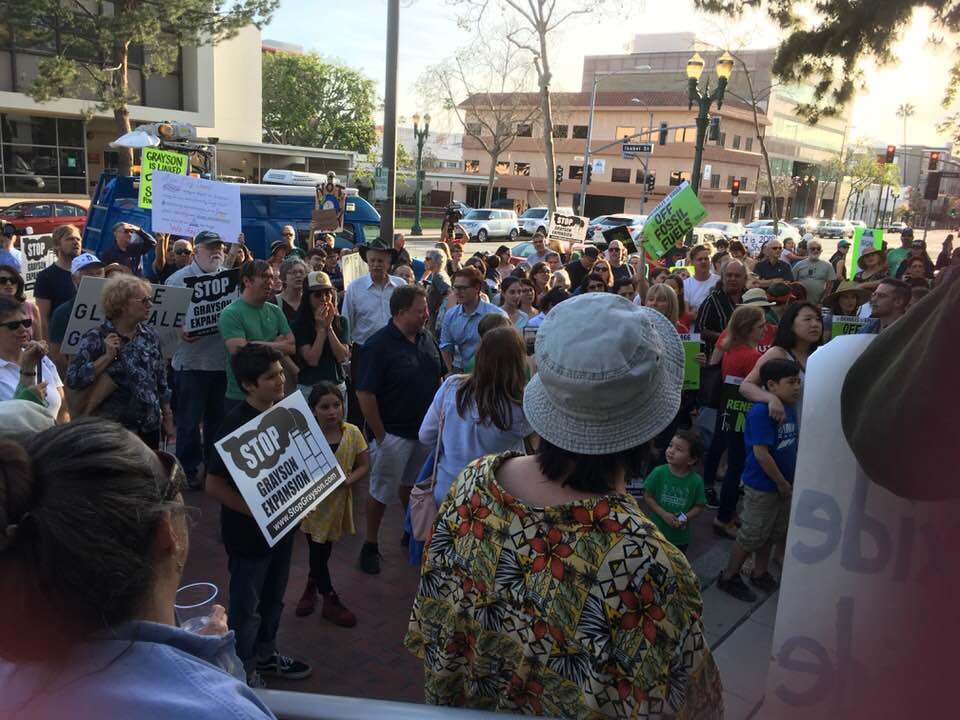For the last few years, Glendale Water and Power (GWP) in California has been itching to repower the Grayson Power Plant, a 173-megawatt gas plant that has been operating in Glendale since the 1940s. The Glendale City Council was scheduled to make a decision on the Grayson Power Plant in 2017, and at the time, despite the science telling us that we must phase out coal and gas as soon as possible, GWP was pushing to spend half a billion dollars of ratepayer money to expand Grayson and keep it running for decades. Most importantly, however, is that Grayson is located in an environmental justice community and is currently the second-most-polluting gas plant in California, meaning that only one other gas plant in our state beats Grayson in terms of pollution.
As Glendale residents and businesses are already overburdened by pollution, extending the life of Grayson and expanding it would be detrimental to their health, safety, and climate -- so the community organized. A broad cross section of the community -- parents, teachers, senior citizens, and students alike -- led by the Glendale Environmental Coalition, regularly attended city council meetings to let their public officials know loud and clear: “We don’t want gas -- we want clean energy instead!” The Glendale City Council listened and postponed making a decision on Grayson until GWP issued a competitive solicitation for clean energy alternatives in lieu of Grayson.
However, after receiving numerous clean energy proposals, GWP continues to argue for the need to repower some of Grayson to keep the lights on. GWP is so certain of this that it spent most of April hosting workshops to persuade Glendale residents and businesses to accept living with a gas plant in their backyard for decades to come, rather than listening to their concerns around health and safety, and a desire for cleaner air.

Photo by Dan Brotman
Glendale Environmental Coalition (GEC) members protesting the Grayson Power Plant.
Utilities have long justified the need for dirty power plants by suggesting that gas is needed to keep the lights on and to avoid constant blackouts. In the past few years, we’ve seen that clean energy -- a cheaper, healthier, and safer alternative for our residents and businesses -- can replace gas. You don’t need to look far to see this. It’s happening all over California: from Pacific Gas & Electric’s decision to replace three gas plants that were running for reliability purposes, to Southern California Edison’s proposal to replace the 262 MW Puente Gas Plant in Oxnard, and most recently, Los Angeles Department of Water and Power’s decision not to repower three coastal gas plants. Grayson is, in fact, the last gas plant under serious consideration in the fifth-largest economy in the world. California will never seriously entertain a gas plant again, which makes Glendale such an outlier in this moment.
Private and public utilities across California have stepped up to the challenge of building a strong and reliable clean energy economy, and we think Glendale does not deserve to be left behind in this transition. As the long list of problems with the project continues to grow, the Glendale community continues to believe that more gas in their neighborhood is unacceptable, and that they too deserve the health and economic benefits of a clean energy economy.
The Glendale City Council is expected to consider the future of Grayson at the end of July. There is a lot of work ahead to realize a 100% clean energy future, but we know GWP can step up to the challenge by moving past Grayson. And when GWP does, the public will be there to support them.